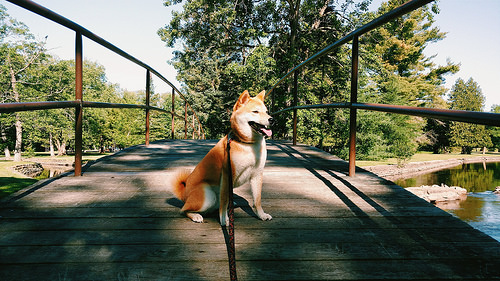Dog walking techniques
by Ontario SPCA and Humane Society | Dog Care | July 12, 2018
There are many ways to teach your dog how to walk by your side – and many tools to assist you! Here are a few different tools you may find useful!

THE WONDERFUL Head halters
Head halters are based on a concept borrowed from horse halters. By controlling your dog’s head and nose, you control the body. When your dog begins to pull, the head halter causes the dog’s nose to be turned down and back toward you, which makes it physically difficult for her to continue pulling. Generally, it includes a link for attaching the leash under the chin. For many dogs, and strong pullers, head halters provide excellent control.
Tip: Head halters require a gradual and positive period of introduction – but are well worth the extra effort. Introduce it slowly by simply showing your dog the halter, treating her, than returning it to a drawer numerous times over a week or so. When your dog sees the halter, and automatically looks eagerly for her treat, she’s ready for step two. Next, put the halter on your dog for very short periods of time, feed treats the entire time to distract her, and remove it. Never take the halter off your dog when she’s pawing her face or making a fuss (otherwise you’ll train her to repeat the behaviour each time you put it on). Instead, distract your dog with a request, toys, playing etc., and then remove it. Practice having your dog wearing it for short periods (e.g. during commercials) before you take it “on the road.” Click here to learn more.
Pressure harnesses
Pressure harnesses fit like a flat body harness, but discourage pulling by tightening on the chest or under the forelegs when your dog tugs forward. The best ones have a cushion on the tightening cords. Some dogs can learn to pull wearing these, but they often interrupt pulling long enough to train better walking. This tool is most effective with medium to mild pullers. It is readily accepted by dogs and does not need a period of introduction.
Front-clip control harnesses
Front-clip control harnesses look like a regular body harness except that the leash attaches in front instead of over the shoulders. When your dog pulls, the tension in front of her chest reorients her back towards you. It works to reduce pulling immediately for many dogs and continues to work well as a management tool over time.
Limited slip collars (Martingale)
These collars are a combination of “slip” and “quick-release” collars with a two loop design. The leash is attached to the smaller loop and is engineered to tighten the larger loop when more control is needed without actually constricting around the dog’s neck. The collar uses light discomfort to discourage pulling in sensitive dogs by tightening around your dog’s neck when he pulls (without choking), and staying loose around your dog’s neck when he’s walking nicely. This is also useful for dogs that are fearful and/or can back out of a regular collar (e.g. greyhounds, because their necks are larger than their heads). It comes in two versions: one has a small nylon loop, the other has a small chain loop (the larger loop that fits around the dog’s neck is nylon).
For more information, visit our fact sheet Wonderful Walking Tools!
Categories
Testimonial
Speaking for the ones who can’t speak for themselves
Keep up the good work speaking for the ones who can’t speak for themselves. A society who cares for their animals is a better society. Thanks for your good work!
